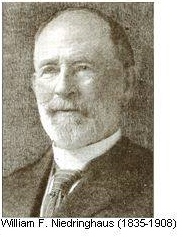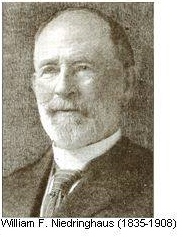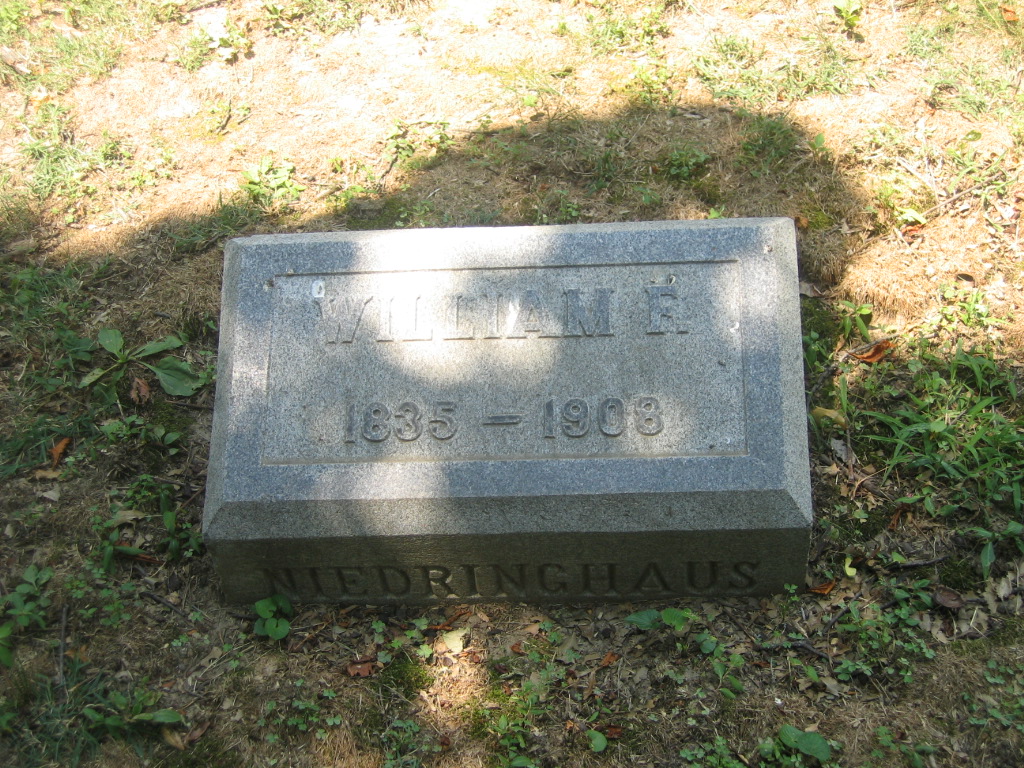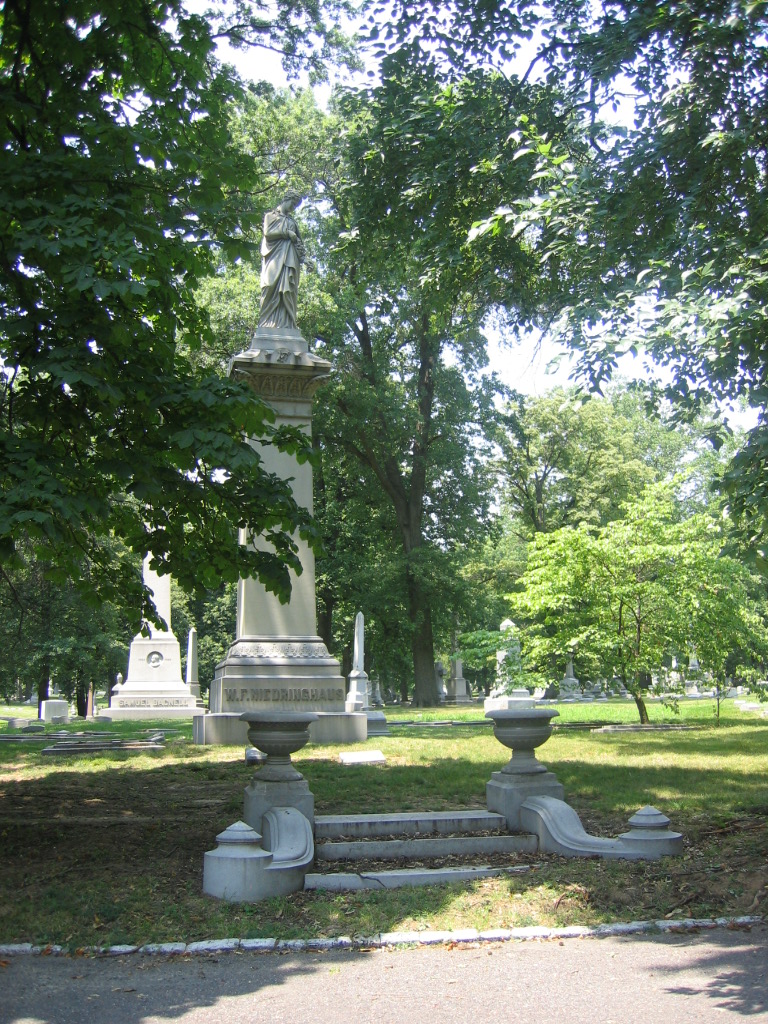Frederick and William Niedringhaus came to St. Louis about 1858 from Westphalia, Germany, where their father had trained them to be tinners & glaziers. With $1,000, they began their own company, making handmade kitchen utensils. But a few years later, they began experimenting with stamping them out of sheet metal. Affordable and durable, they captured the public's favor, and with no seams, they didn't leak, without the need for welding or solder. By the end of the Civil War, they were one of only two companies in the country using this process. As business grew, they purchased a large parcel of ground along the river, north of downtown. Starting with a four-story manufacturing, warehouse, and office building, seven additional buildings would be added; and just north of there, a large steel-rolling mill was erected. With connections to both river and rail, they easily obtained the material needed for the 700 employees to produce 20 tons of sheet metal per day.
At this time, two other companies in America were experimenting with enamel-coated cookware, but no one had discovered how to keep the iron from oxidizing when it came in contact with acidic foods & oils under heat. Modifying a process he witnessed in Europe, William Niedringhaus mixed iron oxide in the molten glass, and applied a speckled artistic pattern, giving the product the look of granite, and the name it would come to be known as, Graniteware. Patented in 1876, Granite Iron Ware was cheap, lightweight, and nearly indestructible.
Needing a larger facility and unable to expand their present site, the company purchased 3,500 acres across the river, in an area known as Kinder. Hiring the St. Louis City Engineer to lay out a new town, the plat map was filed May 29, 1893 and construction soon began. The following year, the city's official name was changed to Granite City, and it was incorporated in 1896.
Wanting to reflect their national presence and worldwide appeal, the name of the St. Louis Stamping Company was changed to the National Enameling and Stamping Company, or NESCO, and in 1927 one part of the company, Granite City Steel, was split off, becoming its own entity.
In 1924, NESCO employed 4,000 people, and had $30 million in assets. Their plant covered 75 acres, with floor space of 1.25 million square feet. But America would change, and with the increased use of aluminum and stainless steel cookware, as well as the later introduction of Pyrex & Corning Ware, NESCO closed their doors in 1956.
Frederick and William Niedringhaus came to St. Louis about 1858 from Westphalia, Germany, where their father had trained them to be tinners & glaziers. With $1,000, they began their own company, making handmade kitchen utensils. But a few years later, they began experimenting with stamping them out of sheet metal. Affordable and durable, they captured the public's favor, and with no seams, they didn't leak, without the need for welding or solder. By the end of the Civil War, they were one of only two companies in the country using this process. As business grew, they purchased a large parcel of ground along the river, north of downtown. Starting with a four-story manufacturing, warehouse, and office building, seven additional buildings would be added; and just north of there, a large steel-rolling mill was erected. With connections to both river and rail, they easily obtained the material needed for the 700 employees to produce 20 tons of sheet metal per day.
At this time, two other companies in America were experimenting with enamel-coated cookware, but no one had discovered how to keep the iron from oxidizing when it came in contact with acidic foods & oils under heat. Modifying a process he witnessed in Europe, William Niedringhaus mixed iron oxide in the molten glass, and applied a speckled artistic pattern, giving the product the look of granite, and the name it would come to be known as, Graniteware. Patented in 1876, Granite Iron Ware was cheap, lightweight, and nearly indestructible.
Needing a larger facility and unable to expand their present site, the company purchased 3,500 acres across the river, in an area known as Kinder. Hiring the St. Louis City Engineer to lay out a new town, the plat map was filed May 29, 1893 and construction soon began. The following year, the city's official name was changed to Granite City, and it was incorporated in 1896.
Wanting to reflect their national presence and worldwide appeal, the name of the St. Louis Stamping Company was changed to the National Enameling and Stamping Company, or NESCO, and in 1927 one part of the company, Granite City Steel, was split off, becoming its own entity.
In 1924, NESCO employed 4,000 people, and had $30 million in assets. Their plant covered 75 acres, with floor space of 1.25 million square feet. But America would change, and with the increased use of aluminum and stainless steel cookware, as well as the later introduction of Pyrex & Corning Ware, NESCO closed their doors in 1956.
Family Members
-
![]()
Lida M. Niedringhaus West
1861–1918
-
![]()
George Wallace Niedringhaus
1864–1928
-
![]()
Walter C Niedringhaus
1867–1886
-
![]()
Albert William Niedringhaus
1869–1944
-
![]()
Olint Niedringhaus Papin
1872–1909
-
![]()
Oliver B Niedringhaus
1874–1916
-
![]()
Jeannette Niedringhaus Orthwein
1875–1940
-
![]()
Maude A Niedringhaus Young
1878–1921
-
![]()
Lee Irvin Niedringhaus
1881–1933
-
![]()
Lucille Niedringhaus Drew
1884–1928
-
![]()
Irene Alta Niedringhaus Randolph
1884–1946
Sponsored by Ancestry
Advertisement
Explore more
Sponsored by Ancestry
Advertisement


























